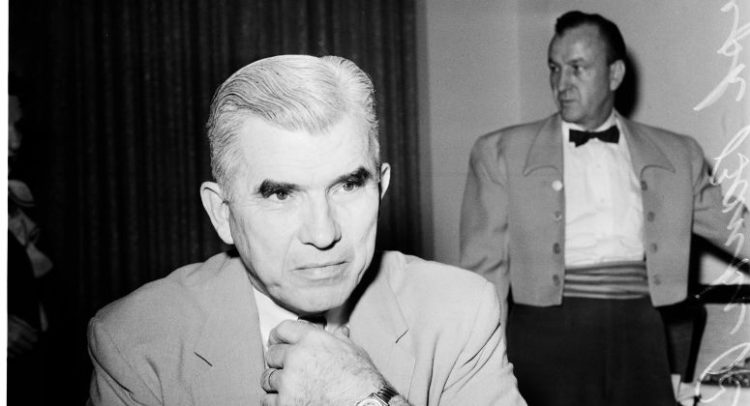Is There Intelligent Life on Earth? (part 5)
by Revilo P. Oliver
The Pip-Squeak Effect
IN America’s Decline I quoted, from a journal that I kept in my youth, an entry made in 1934, when I tried to analyse the probable shape of the coming World War at a time when our “intellectuals” were blabbering about “world peace” and similar niaiseries. I quoted it to show that I did not then even suspect the decisive power of the alien race that had infiltrated our nations. In the same year, I devoted two lines of sarcasm to what seemed to me a particularly silly book that was, thanks to intensive publicity, starting a fad that I expected to be the usual nine days’ wonder. It wasn’t a fad; it was a craze that is still going strong, half a century later.
The evil that dupes do lives after them. When Sir Arthur Conan Doyle was gravely telling ghost stories to enraptured audiences in the early 1920s, one of his auditors was a man nearly thirty who had started out to purvey salvation from a pulpit, thought better of it, and taken a respectable degree in botany. He had not rid himself, however, of his thirst for eternal life and psychic mysteries.15 According to his own statement, he was inspired by the “exhilarating thoughts” of “transcendental importance” in Sir Arthur’s weird tales. A few years later, the exhilarated Dr. Joseph Banks Rhine, ensconced in Duke University, got an opportunity to make big noise about “extra-sensory perception” and set agog with “psi power” and “parapsychology” the many persons who yearned to be exhilarated by old hokum put into new words.
The botanist who turned into a parapsychologist may be acquitted of conscious fraud on the strength of the dazzling naïveté with which he described his methodology in his first book (1934). As the eminent D. H. Rawcliffe remarked in his Psychology of the Occult (1952; reprinted by Dover under the title Occult and Supernatural Phenomena, but now oddly out-of-print), “That Dr. Rhine should have published the results of such experiments in the first instance as evidence of telepathy or clairvoyance is almost incredible. Nothing can dispel the impression of carelessness thus created.” Dr. Rhine’s “discovery” was indeed wonderful, but what was wonderful about it was the sheer désinvolture of a self-styled scientist who considered success at guessing cards a little more often than chance as proof of “extra-sensory perception” and failure to guess them as often as chance as proof of “negative ESP”! For the details of the methods and the results thus obtained, I refer you to Dr. Rawcliffe and to Dr. Martin Gardner’s Fads and Fallacies in the Name of Science (1952; reprinted by Dover; still in print).
It was, as Mr. Rawcliffe said, “almost incredible” that Dr. Rhine should have taken seriously such patently flimsy data, but we all know that overheated brains develop psychic powers of self-deception. What stuns us is what should be unbelievable, the appalling fact that men of accomplishment in the exact sciences took those absurdities seriously and did not merely laugh at “parapsychology” as another foolish fad, comparable to flag-pole sitting and marathon dancing. Now let us understand clearly why they should have guffawed and turned their minds to something serious, such as a cross-word puzzle.
There was nothing per se preposterous in a suggestion that telepathic communication was possible. The human brain, as is well known, emits electrical waves that can be detected by an electroencephalograph, which will, for example, invariably show that the alpha-rhythm supervenes in your own brain whenever you close your eyes firmly for more than an instant. It is conceivable, therefore, that a brain that emits such waves could detect them when emitted by others. And although there never has been a verifiable instance of telepathic communication, an extraordinary genetic combination or even mutation might conceivably produce a person with an extremely high sensitivity to such waves, comparable, perhaps, to the phenomenal development of the tactile sense in some blind women, who identify colors in some woolen fabrics by slight changes in the “feel” of the strands produced by the different dyes used.16
It is certain, moreover, that there are senses which we do not possess — except, just possibly, in some very rudimentary form of which we are not conscious. We do not even know to what stimuli the senses we do not possess respond, although there are good conjectures that the earth’s magnetic lines of force may be one of them. We simply do not know what curlews, geese, tarn, and other birds must perceive in their annual migration half-way around the globe, so that they can, for example, fly unerringly from a swamp in Africa to a tiny island in the North Sea and there find the precise spot on which they nested before. We do not know how salmon find their way through hundreds of miles of ocean and rivers and their tributaries to the exact point that is the individual’s spawning ground. Nearer to us are the baboons, who have a social organization (and possibly even a belief in the supernatural17) that deserves the attention of the few sociologists who are interested in studying society rather than in manufacturing propaganda to change it. Reliable observers report that a baboon can identify a human friend at a distance at which the human eye sees only a black figure on the horizon. They report that if a baboon is transported in a closed vehicle over a route that is roughly triangular, from one extremity of the base up to the apex and then down to the other end of the base, he will, when released, return home by the direct route across the base, perceiving the direction of his home by some sense that responds to stimuli we cannot detect with our senses or any instruments we have devised. Now it is as unlikely that a human being should be born with the peculiar intelligence of curlews, salmon, or baboons as it is that he should be born with wings. But perhaps such a lusus naturae could be conceivable at the very limit.
It is not the extreme improbability of the phenomena that Dr. Rhine undertook to discover that merits our wonder — yes, and scorn. What is simply astounding is that men with scientific training wasted as much as ten minutes on consideration of the results obtained and reported by Dr. Rhine himself, since he appears not to have indulged in the deliberate fakery to which so many of his “scientific” endorsers and assistants (e.g., that great “authority on parapsychology,” Dr. Walter J. Levy, Jr.) resorted. We all have some conception of what is likely, and a scientist should, by definition, have a knowledge of the laws of probability of single events and the probability of series, or, in other words, distinction between physical probability and statistical probability, remembering that the latter, calculated by extending the familiar binomial formula applies only to very large numbers.
Everyone knows that if he tosses a penny into the air, the chances are one out of two that it will come down heads. If heads turn up on three successive throws, you may be mildly surprised. If they turn up four times in succession, you may think it odd, but although your achievement is as stupendous as any of Dr. Rhine’s, you will not conclude that your mighty mind governed the fall of the penny or that some deity broke a record by intervening in the affairs of this world. Unless you have thought about it, however, you may not have it firmly in your mind that the chances that heads will again turn up on the fifth throw are precisely one out of two. And if you toss the penny twenty-five times and obtain heads each time, you will have witnessed a quite unusual event, although not one without precedent, as they will tell you at Monte Carlo, where a phenomenal sequence of red on the roulette wheel is still remembered. It will be unusual and even extraordinary, comparable to your experience of venturing into the concrete jungle of New Jerusalem-on-the-Hudson and meeting on Broadway a Texan whom you knew in college, but let not the result you obtain from the binomial formula convince you that you are endowed with a high-voltage psyche. And remember that by physical probability the chances that heads will turn up on a twenty-sixth throw are still one out of two, despite the statistical improbability of so long a series.
The basis of all scientific, and indeed of all rational, thought, is the fact — indubitable unless we are living in a cosmic madhouse run by an insane god, as Flaubert once suggested — that the forces of nature operate uniformly and without variation. Under the same circumstances, the same forces exerted on the same object always and invariably produce the same result. Now what Dr. Rhine’s experiments produced were positive or negative “runs” that yielded a piddling percentage according to the binomial formula. That was in itself sufficient to show that his conclusions were illusory and disproven by his own reports.
Experiments have shown that if you capture albatross on Midway Island, transport them in closed containers 3,120 miles to Puget Sound and there release them, they will return home, across the open ocean and in spite of storms, in ten to twelve days. And, so far as we know, they will do this, not 0.9% above chance, but 100%, provided, of course, they are not the victims of birds of prey or shotguns en route. Now if there are “psychically endowed” persons who, like albatross, have faculties we do not have, they must, by the uniformity of nature, be able to make almost as good use of those faculties. What Dr. Rhine proved was that if such highly improbable persons did exist, they neglected to call on him.
As soon as this canard was given publicity by journalists eager to set agog the boobs who read their drivel, it was only natural that a horde of charlatans should turn from the stale old tricks of tipping tables and exhibiting phosphorescently painted gauze in dark rooms to a superficially novel racket and become “parapsychologists” instead of “spiritual mediums.” But what is inexplicable is that men who had evinced a knowledge of scientific methods should have so far taken leave of their common sense as to waste more than a chuckle on anything so patently absurd. But the grim and terrible fact is that they did and lent such credence to the nonsense that I know not how many laboratories were endowed and how many earnest and presumably honest wights with scientific credentials from respected universities were laboring to find scientific evidence of the unbelievable and were, of course, suckers for any moderately clever swindler who could give them the desired results.
This epidemic of scientific unreason became so contagious that it was finally necessary for Mr. Randi to send two young conjurors into the great laboratories and show the self-styled scientists that they were chumps and should be grateful to Fate that no one had offered them a chance to buy the Brooklyn Bridge for twenty-five dollars. They couldn’t have resisted that offer — not, at least, if the vendor mentioned the binomial theorem and added a bit about non-Euclidean geometry.
Mr. Randi is publishing a detailed report of these adventures of his young protégés in the great laboratories in which professed scientists anxiously search for Santa Claus. The first installment was published in the Summer 1983 issue of the Skeptical Inquirer.18
* * *
Source: Liberty Bell publications; transcribed by Racial Idealism







